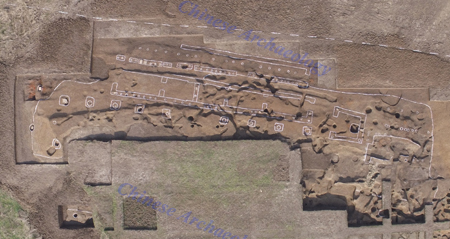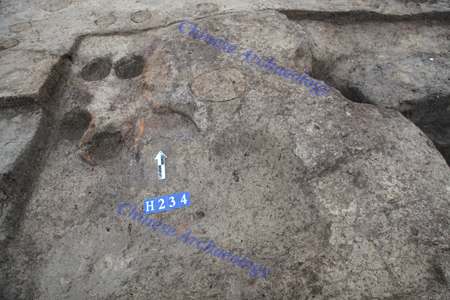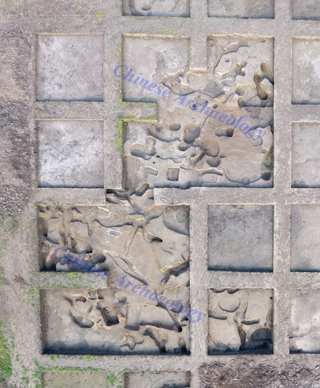Information
A bronze-casting workshop was discovered in Taijiasi archaeological site in Anhui province
Summary: Taijiasi site is situated in Sanhe village, Zhuzhai town, Funan County, Anhui province. Since 2014, A 3-year period archaeological work was carried out by Anhui Provincial Institute of Cultural Relics and Archaeology and Department of Archaeology of Schoo
A bronze-casting workshop was discovered in Taijiasi archaeological site in Anhui province
From:Chinese Archaeology Writer: Date:2017-06-20
Taijiasi site is situated in Sanhe village, Zhuzhai town, Funan County, Anhui province. Since 2014, A 3-year period archaeological work was carried out by Anhui Provincial Institute of Cultural Relics and Archaeology and Department of Archaeology of School of History of Wuhan University. The total excavation area is 2500 square meters. The chronology, cultural characteristics, and settlement structure of the site were determined during the excavation. Many important remains, including the complete square circumambient moat, large-scale building structures, bronze-casting remains, foundation pits, sacrificial pits, and royal tombs were uncovered along with a large amount of artifacts, which reveals the production, daily life, and mortuary practices of the high nobles during Shang dynasty.

During the three years of excavation, 16 house foundations, 273 ash pits, and 7 tombs that belong to the Shang dynasty were uncovered. The main types of ceramics found at the site are similar to the ones discovered from other Shang cultural remains in Central Plains, including earthen pots (tripod Li), cooking and steaming vessel yan, basin, food container gui, pots, fake belly dou steamed plate, large-mouthed vessel zun. The Taijiasi site is dated to the period from the late early-Shang dynasty to the early late-Shang dynasty, of which Huanbei Shang walled-city period was the most developed period.
There are five platforms found at the site. The residential area for the nobles was surrounded by the square circumambient moat. The tombs are situated on a platform 200 meters away from the west part of the noble residential area. Three small-sized and less-accumulated residential areas for common people are located around 500-700 meters at the periphery of the noble residential area.

A large square moat facilities with a corner cut on the northeast part was found in the noble residential area. It is about 105 meters long from east to the west, 85 meters long from south to the north, and 13-15 meters wide. It was probably used during Shang dynasty and filled up during the Zhou dynasty.
The discovery of large-scale building remains of Shang dynasty
All the large building remains of Shang dynasty were found inside the noble residential area at the site. They are relatively large. All the individual buildings were with a similar style and building scheme to those in Shang styles. They were densely distributed and have varied structures and functions. Currently, it is confirmed that the group of large buildings at the north part and those at the east part were belonged to the high nobles.

The large building at the north part is situated on a rectangular platform. It consists of large palace buildings F2 and F12, a storage room F14, a bronze-casting workshop F16, and a warehouse F15.
The large building F18 of the east part faces to the public square at the south of the north palace. Its foundation trenches were rammed by small stick-like tools. The plane structure of the building is in the shape of “品”. There are three rooms from the north to the south.
Many sacrificial pits were uncovered from the south part of the north building and the west part of the east building. There are three types of sacrificial pits – sacrificial pits with human remains, potteries, and bone oracles. However, only small quantities were found.
The discovery of Shang dynasty tombs
The Shang dynasty tombs were all found on a platform that locates 200 meters away from the west of the noble residential area. Seven Shang dynasty tombs were excavated. 13 funeral objects were uncovered. The Shang dynasty tombs M1, M2, M3, M4, M6, and M7 are all earthen-shaft tombs. Each tomb has a single wooden coffin with round bottom and an oval-shaped waist pit. The remains of a dog were found in the waist pits except tomb M3, the dog and the tomb owner face to the same direction. These tombs are dated to Huanbei Shang walled-city period.

A group of ash pits filled with bronze-casting wastes was found at the south part of the circumambient moat, close to the center of the noble residential area. A small amount of ceramic fragments, large quantity of furnace wall pieces, clay moulds, and slag were uncovered from these pits. 1106 clay moulds were found from 28 ash pits. According to the shape of the bronze-ware, the ornamentation on the moulds and the coexistent artifacts, it suggests that these clay moulds are also belonged to Huanbei Shang walled-city period.
On the other hand, the used oracle bones and tortoise-shells were uncovered from Taijiasi site. The repair, drill, chisel, and burn marks on the oracles are similar to the marks on the ones found in the Central Plains of the same period. The main mammal species are deer, pig, and cattle. Among them, the quantity of pig remains uncovered is relatively high while only small amount of cattle remains were uncovered.
Academic significance
Taijiasi site is a typical example of the platform-shaped site, which is the dominant settlement pattern in the Huaihe River basin and Jianghuai area from the Longshan culture period to the Spring and Autumn period.
The large platform foundation at the north part of the noble residential area and the three large scale buildings uncovered from the Taijiasi site are typical Shang cultural buildings. It is one of the largest Shang dynasty palace remains found throughout the south China only next to those in Sanxingdui and Panlongcheng site. Also, it is the first time to discover the “品”-structured building in Shang culture, which promotes our research on the ancient architectures of Xia, Shang, and Zhou dynasties.

The bronze-casting workshop discovered at Taijiasi has rich artifacts and complete evidence of bronze-casting process. It is the first bronze-casting workshop discovered apart from the two Shang capital sites, which has proved that bronzes could be made outside the capital and the technical level was as well as it in the capital. Also, it gives very important direct evidence to the control and allocation of metal resources, as well as the control and spread of bronze-casting techniques in Shang dynasty. (Translator: Li Xuelei)

During the three years of excavation, 16 house foundations, 273 ash pits, and 7 tombs that belong to the Shang dynasty were uncovered. The main types of ceramics found at the site are similar to the ones discovered from other Shang cultural remains in Central Plains, including earthen pots (tripod Li), cooking and steaming vessel yan, basin, food container gui, pots, fake belly dou steamed plate, large-mouthed vessel zun. The Taijiasi site is dated to the period from the late early-Shang dynasty to the early late-Shang dynasty, of which Huanbei Shang walled-city period was the most developed period.
There are five platforms found at the site. The residential area for the nobles was surrounded by the square circumambient moat. The tombs are situated on a platform 200 meters away from the west part of the noble residential area. Three small-sized and less-accumulated residential areas for common people are located around 500-700 meters at the periphery of the noble residential area.

A large square moat facilities with a corner cut on the northeast part was found in the noble residential area. It is about 105 meters long from east to the west, 85 meters long from south to the north, and 13-15 meters wide. It was probably used during Shang dynasty and filled up during the Zhou dynasty.
The discovery of large-scale building remains of Shang dynasty
All the large building remains of Shang dynasty were found inside the noble residential area at the site. They are relatively large. All the individual buildings were with a similar style and building scheme to those in Shang styles. They were densely distributed and have varied structures and functions. Currently, it is confirmed that the group of large buildings at the north part and those at the east part were belonged to the high nobles.

The large building at the north part is situated on a rectangular platform. It consists of large palace buildings F2 and F12, a storage room F14, a bronze-casting workshop F16, and a warehouse F15.
The large building F18 of the east part faces to the public square at the south of the north palace. Its foundation trenches were rammed by small stick-like tools. The plane structure of the building is in the shape of “品”. There are three rooms from the north to the south.
Many sacrificial pits were uncovered from the south part of the north building and the west part of the east building. There are three types of sacrificial pits – sacrificial pits with human remains, potteries, and bone oracles. However, only small quantities were found.
The discovery of Shang dynasty tombs
The Shang dynasty tombs were all found on a platform that locates 200 meters away from the west of the noble residential area. Seven Shang dynasty tombs were excavated. 13 funeral objects were uncovered. The Shang dynasty tombs M1, M2, M3, M4, M6, and M7 are all earthen-shaft tombs. Each tomb has a single wooden coffin with round bottom and an oval-shaped waist pit. The remains of a dog were found in the waist pits except tomb M3, the dog and the tomb owner face to the same direction. These tombs are dated to Huanbei Shang walled-city period.

A group of ash pits filled with bronze-casting wastes was found at the south part of the circumambient moat, close to the center of the noble residential area. A small amount of ceramic fragments, large quantity of furnace wall pieces, clay moulds, and slag were uncovered from these pits. 1106 clay moulds were found from 28 ash pits. According to the shape of the bronze-ware, the ornamentation on the moulds and the coexistent artifacts, it suggests that these clay moulds are also belonged to Huanbei Shang walled-city period.
On the other hand, the used oracle bones and tortoise-shells were uncovered from Taijiasi site. The repair, drill, chisel, and burn marks on the oracles are similar to the marks on the ones found in the Central Plains of the same period. The main mammal species are deer, pig, and cattle. Among them, the quantity of pig remains uncovered is relatively high while only small amount of cattle remains were uncovered.
Academic significance
Taijiasi site is a typical example of the platform-shaped site, which is the dominant settlement pattern in the Huaihe River basin and Jianghuai area from the Longshan culture period to the Spring and Autumn period.
The large platform foundation at the north part of the noble residential area and the three large scale buildings uncovered from the Taijiasi site are typical Shang cultural buildings. It is one of the largest Shang dynasty palace remains found throughout the south China only next to those in Sanxingdui and Panlongcheng site. Also, it is the first time to discover the “品”-structured building in Shang culture, which promotes our research on the ancient architectures of Xia, Shang, and Zhou dynasties.

The bronze-casting workshop discovered at Taijiasi has rich artifacts and complete evidence of bronze-casting process. It is the first bronze-casting workshop discovered apart from the two Shang capital sites, which has proved that bronzes could be made outside the capital and the technical level was as well as it in the capital. Also, it gives very important direct evidence to the control and allocation of metal resources, as well as the control and spread of bronze-casting techniques in Shang dynasty. (Translator: Li Xuelei)
Category: English
News
Information
Key words:
